

Journal of Okayama Medical Association
Published by Okayama Medical Association<Availability>
Full-text articles are available 3 years after publication.
Permalink : https://ousar.lib.okayama-u.ac.jp/17106
踵骨の骨梁構造に関する研究
中山 浩
岡山大学医学部整形外科学教室
発行日
1980-08-31
抄録
Human calcaneus was taken from twelve amputated limbs. Specimens were embedded in polyester resin and serial section in frontal, sagittal and horizontal plane were carried out. Microradiographic examination of each section was used to study the contour of the calcaneus, the density and arrangement of the bone trabeculae. The results were summarized as followings: 1, The most characteristic architecture was observed in the sagittal plane. The trabeculae were divided into five groups; (a) trabeculae originated vartically from the facies articularis talaris posterior and reached to the tuber calcanei. (b) trabeculae originated from upper part of the facies articularis cuboidea and reached to the lower part of the tuber calcanei. These trabeculae arranged in an arch form whose apex was just under the sulcus calcanei. (c) trabeculae showed reversed curvature of the (b) trabeculae. (d) trabeculae run parallel to the posterior contour of the tuber calcanei. The trabeculae had the width of about 5mm. (e) trabeculae originated from the sulcus calcanei and run downwars rather diversely. 2. These findings indicated that the trabeculae of the five groups had different function in each; (a) supported body weight, (b) was a part of the longitudinal foot arch, (c) supported (b), (d) corresponded to tension force of the Achilles tendon and (e) corresponded to tension force of the lig. talocalcaneum interosseum as well as bending force which acted on the sustentaculum tali. 3. From these observations it was suggested that the trabecular architecture of the calcaneus was not influenced by dynamic factors but corresponded to static forces i.e. body weight as well as support of the longitudinal foot arch.
キーワード
踵骨
骨梁構造
pressure trajectory
tension trajectory
trajectorial theory
ISSN
0030-1558
NCID
AN00032489
